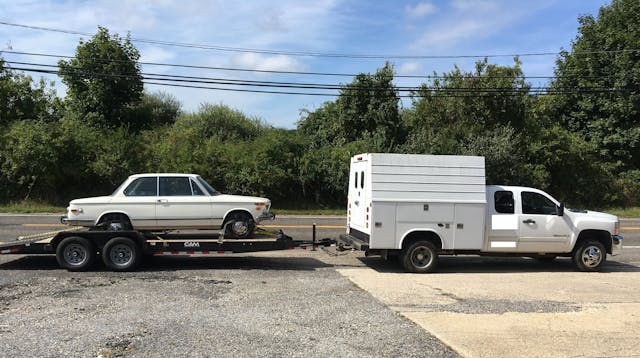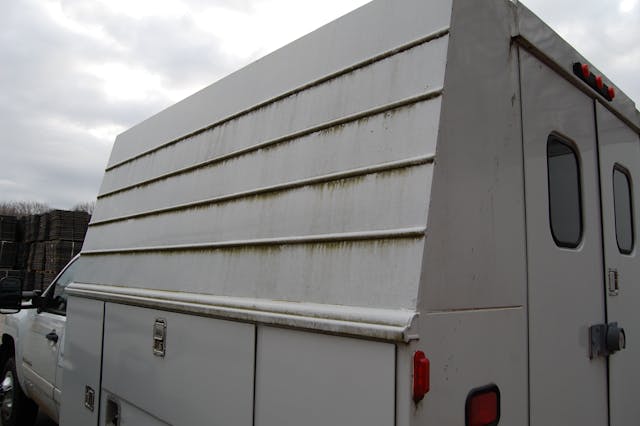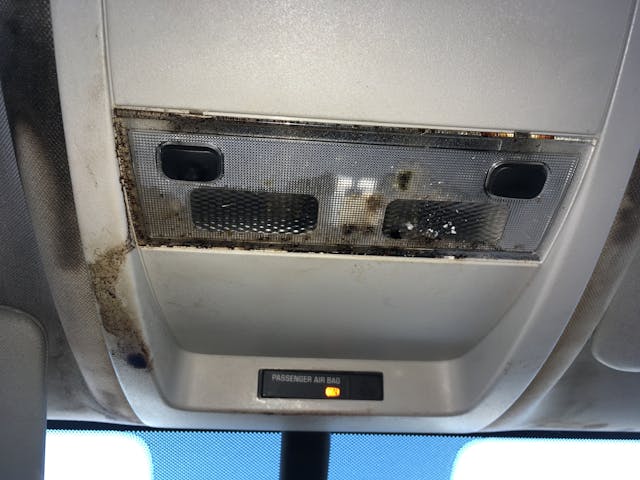The mouse-infested truck: Deal or no deal?

One of the little bits of Hack Mechanic stage patter I’ve gotten decades of mileage out of is saying that a car nut needs three cars—the daily driver, the family hauler, the pampered classic, the track rat, the sunny-day roadster, the tow monster / stuff hauler / 4WD beach assault vehicle, and whatever the current project car happens to be. Like I said, seven cars. And I have nearly twice that many.
During the decades I took my family on vacation to Nantucket, the role of the stuff hauler / beach assault vehicle was performed by a series of Suburbans. I loved the utility of these vehicles, their ability to swallow seemingly endless amounts of people and stuff, to drive over sand to get to the good fishing spots, and yes, to tow home the crimes of opportunity that comprise my hoard of cars. But when the kids were gone and the last ’Burb got too rusty to pass inspection in 2015, I allowed that era to end. Two years later, I bought my little Winnebago Rialta RV. My wife and I love taking it for three-day jaunts to the beach—and owning a vehicle with a bathroom is almost life-changing. However, while the Rialta is similar in size to the Suburban and occupies the same physical space in our driveway, the functional similarities are very few. It has front-wheel drive, its interior cargo-carrying capability is limited by its narrow side door, and with its little 105-horsepower five-cylinder engine, you can’t put anything bigger than a bike rack on the trailer hitch. Really, the last thing it is is a tow monster / stuff hauler / beach assault vehicle.
A notice to readers: Comments on new Hagerty articles have been disabled due to technical issues since July 29th. Don’t worry, the comments are coming back soon, and when they do, we’ll have a contest or giveaway to reward our readers for their patience. Never stop driving! — Jack Baruth
Fortunately, when I needed to drag a car home, I still had a truck up my sleeve. For over 30 years, I was a geophysical engineer, working in the field (literally) of detection of unexploded ordnance (UXO) left over from military training exercises. We used a Gator-like UTV to tow a platform the size of a boat trailer, instrumented with an array of metal detectors and centimeter-accurate GPS. (Yes. Tow. Buried dud bombs aren’t land mines. They don’t explode when you drive over them.) The equipment was transported in a 32-foot trailer. For 15 years, the trailer was hauled by a 1992 Ford F350, but when that truck got long in the tooth, the company sprung for a 2008 Chevy Silverado 3500HD dually with a utility body on the back and the best tow package you could buy—the Duramax diesel engine and the Allison six-speed transmission. Talk about a tow monster. This thing could yank a house off its foundation.


Unfortunately, by 2013, most of the UXO detection work had gone away, and the truck basically sat, having only accumulated about 28,000 miles. The lack of work caused the company to close the building I worked in. I hustled and found a small industrial space for me and three other employees, but zoning required the truck and trailer to be parked elsewhere. I negotiated a parking deal with a guy two buildings over.
In 2015, I become a full-time automotive writer, but I remained a consulting employee to my longtime geophysics job. For a couple of years, there was still a fair amount of work. And, as courtesy that also had a lot of enlightened self-interest to it, I continued to be the Silverado’s caretaker, keeping it inspected and communicating with people in the company about annual insurance and registration renewals. I also continued to manage the parking for the truck and trailer, as it seemed that every few years, the building or lot where they were parked would get sold, and I’d have to scramble to find someplace else nearby to park them.
But because of this, I got to use them—under the wink-and-a-nod guise of “exercising the equipment”—to move my children in and out of apartments, buy lumber and engines, and, yes, to occasionally tow cars. Generally, if all I needed to do was tow a car, I borrowed only the truck and rented a U-Haul auto transporter, as the 32-foot trailer was massive overkill and a bit of a handful. Readers may recall the story about my buying the 48,000-mile 1973 BMW 2002 in Bridgehampton, Long Island, two years ago. It was the fact that I went down there with the borrowed truck that enabled me to buy the car and drag it home.

The fact that the truck and trailer were stored outside, though, took its toll. Mice got into the truck. Thereafter, whenever I turned on the heater or A/C blower, bits of wool scavenged from some unknown source would fly out of the vents. I began leaving dryer sheets and peppermint oil in the cab, but it made no difference. The last few years, the only commercial parking I could find was two spaces (one for the truck, the other for the trailer) costing $350/monoth each at a facility that serviced commercial transit vehicles (trucks and busses). The parking spots were on the edge of a lot that backed onto woods with a small creek. Unknown to me, it was rodent central, and the mouse problem became a lot worse. On the Bridgehampton drive, the mouse odor was so strong that I needed to keep the windows rolled down.


From an asset management standpoint, as is often the case when very large companies buy small ones, reorganize, and close divisions, my former employer was barely aware of the existence of the truck. The person for whom I’d worked for many years had left. My new contact was a colleague of mine, but the folks above him didn’t really know anything about the equipment. I hadn’t seen any paid work from the company in several years, my geophysics career was clearly long since over, and it was starting to seem ridiculous that the only reason I was remaining an in-name-only employee was so I could legally borrow a truck.
So, about a year ago, I broached the idea of buying the truck from them. I made them a low offer, it was sent up the chain, and they accepted—and then reneged when they located the truck on a corporate asset sheet and found that there was still $12K of undepreciated value left on the books. They asked me if I’d increase my offer. I nudged it up slightly. There was no formal response.
When I visited the truck in early spring, I found that the mouse situation had exploded. The stench of rodent in the cabin was overpowering. Mice had clearly gotten into the headliner, as it was badly stained, with thick brown fluid literally oozing out of the map light panel.


In addition, I also found that a majority of the truck’s six original 2008 tires were cracking.

On the one hand, nothing (the mouse smell notwithstanding) was preventing me from continuing to use the truck if I needed it. It was registered and insured. I kept it inspected. I had a gentleman’s agreement that keeping it “exercised” was good for it. I had the keys. Hell, I even had the title. But if it broke down or was in an accident, it would’ve been messy, and those cracked tires were a clear warning sign. I thought about it carefully. I did want a truck, and the fact that this one had the coveted Duramax diesel / Allison transmission and only 28,000 miles gave it a lot of value, even with the mouse stench. Hell, the engine alone was probably worth $10K, the transmission $6K. Not that I had any interest in parting it out, but this all factored into a calculation of risk versus reward. Hey, one person’s mouse-infested truck is another person’s treasure.
So, I photographed the evidence of the mouse infestation and the cracked tires, sent the pictures to my former employer, and made a ridiculously low $2000 take-it-or-leave-it offer. I also noted that, had they simply accepted my offer a year ago, they would’ve saved themselves $4200 in parking costs at the commercial lot in which the truck was sitting. Again, there was no formal response. Ah, the efficiencies of large, publicly traded corporations.
Then, this past spring, the company suddenly closed the industrial space where I used to work and liquidated all the equipment inside. Since the truck and trailer were parked in a different location a few miles away, they were spared the pennies-on-the-dollar fire sale to strangers. I gently repeated my offer for the truck, reminding them that, with the building closed, the truck and the trailer were the last of the old geophysics-related equipment to be disposed of. Again, they were non-responsive. A month later, I got a verbal that they were inclined to do it, but they had reversed themselves before, and I was beginning to think that if I wanted a truck, I shouldn’t rely on them to make up their mind and should instead just go out and buy myself something. I figured my needs would be better served by something smaller and less tow monster, like another Suburban or a used Honda Ridgeline.
In late July, the logjam suddenly broke. Someone higher up in the company contacted me, officially accepting my offer. Papers were passed, I wrote the company a check for $2000 and sent it to him, and the work truck was mine. As I’ve written other times, the state of Massachusetts charges sales tax not on what you paid, but on the low NADA book value, and the NADA guide certainly knows what a 2008 Chevy Silverado 3500HD dually with the Duramax / Allison combination and only 28K on the clock is worth. I was assessed taxes on a book value of $21,200. Combined with the registration and title fees, I wrote the registry a check for nearly 3/4 of what I’d paid for the truck.
Still, with sunk costs of only about $3500 ($5000 if you count the six Michelin LTX Defender LT225/75R17 tires that the truck immediately needs), the mouse-infested truck was a stone-cold steal.
If only I could drive it without gagging.
(Next week, Rob brings the Silverado Duramax home, tears into the headliner, and comes face to face with how mouse-infested this truck really is. And, despite his taking twice-daily showers, his wife is threatening divorce.)
***
Rob Siegel’s new book, The Best Of The Hack MechanicTM: 35 years of hacks, kluges, and assorted automotive mayhem, is available on Amazon. His other seven books are available here, or you can order personally-inscribed copies through his website, www.robsiegel.com.

